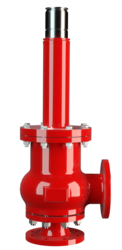DZ/EA-F
Pressure or Vacuum Relief Valve, In-Line With ETFE Lining
- 10% technology for minimum pressure increase up to full lift
- extreme tightness, resulting in lowest possible product losses mand reduced environmental pollution
- based on 10% technology, set pressure is close to opening pressure for optimum pressure maintenance in the system as compared to conventional 40% or 100% technology
- inner lining and material selection makes this type suitable for highly corrosive, polymerizing, or sticky substances
- high flow capacity reduces costs through the use of smaller valves
- can be used as pressure or vacuum relief valve
- compact, space-saving right-angle design
- sturdy housing design (PN 10)
- spring-loaded for high set pressures
- maintenance-friendly design
Función y Descripción
The lined PROTEGO® in-line valve DZ/EA-F is a state-of-the-art pressure or vacuum relief valve in a right angle design for higher set pressures. The lining makes this model a perfect solution for corrosive, polymerizing, or sticky substances. All inner parts are manufactured from PTFE or other highly corrosion resistant materials. Typically, the valve is installed in the in-breathing or out-breathing lines of tanks, vessels, and process equipment to protect against unallowable overpressure or underpressure.
The valve prevents emission losses almost up to the set pressure and prevents unacceptable product entry. This springloaded model allows higher set pressures than the DZ/EA.
The device will start to open as soon as the set pressure is reached and only requires 10% overpressure to full lift. Continuous investments in and a commitment to research and development have allowed PROTEGO® to develop a low pressure valve which has the same opening characteristic as a high pressure safety relief valve. This “full lift type” technology allows the valve to be set at just 10% below the maximum allowable working pressure or vacuum (MAWP or MAWV) of the tank and still safely vent the required mass flow. Due to our highly developed manufacturing technology, the tank pressure is maintained up to set pressure with a tightness that is far above the conventional standard. This feature is ensured by the use of Hastelloy valve seats and with individually lapped valve pallets (1). After the overpressure is released or the vacuum is balanced, the valve re-seats and provides a tight seal.
The optimized fluid dynamic design of the valve body and valve pallet is a result of many years of research, resulting in stable operation of the valve pallet, optimized performance, and reduced product losses.
Dimensiones
To select the nominal size (DN), please use the flow capacity chart on the following page
| DN | 50 / 2" | 80 / 3" | 100 / 4" | 150 / 6" |
| a | 168 / 6.61 | 180 / 7.09 | 200 / 7.87 | 228 / 8.98 |
| b | 167 / 6.57 | 177 / 6.97 | 200 / 7.87 | 232 / 19.13 |
| c | 615 / 24.21 | 785 / 30.91 | 915 / 36.02 | 1160 / 45.67 |
| d | 200 / 7.87 | 240 / 9.45 | 280 / 11.02 | 335 / 13.19 |
Material for housing
| Design | B |
| Housing | Steel |
| Lining | ETFE |
| Cover | Steel |
| Valve seat | Hastelloy |
| Guiding disc | PTFE |
| Valve pallet | A |
Material selection for valve pallet
| Design | A |
| Pressure range [mbar] [inch W.C.] | ±60 up to ±500 ±24 up to ±200 |
| Valve pallet | Hastelloy |
| Spindle / Guiding | Hastelloy |
| Sealing | Metal to Metal |
Tipo de bridas de conexión
| EN 1092-1; Form B1 |
| ASME B16.5 CL 150 R.F. |
Modelo y especificación
The vent pallet is spring loaded. Lower set pressures for pressure and vacuum are achieved by using the type DZ/EA.
In-line pressure or vacuum relief valve, standard design | DZ/EA-F |
Additional special devices available upon request
Within piping systems the influence of backpressure has to be considered in deciding the set pressure and opening characteristics. For special design solutions (e.g. partial load operation) the valve can be supplied with standard valve pallets (with proportional opening function).
Settings
| Pressure or vacuum settings: | ±60 mbar | ±500 mbar | |
| ±24 inch W.C. | ±200 innch W.C. |
Diagrama de flujo volumétrico

Los diagramas de flujo volumétrico han sido determinados con un banco de pruebas de caudal calibrado y certifi - cado por TÜV. El flujo volumétrico V. en [m³/h] y el CFH se refi eren a las condiciones estándar de referencia de aire según ISO 6358 (20°C, 1bar). La conversión a otras densidades y temperaturas están referidas en el Vol. 1: “Fundamentos Técnicos”.




